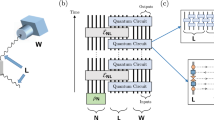Abstract
Is there any hope for quantum computing to challenge the Turing barrier, i.e., to solve an undecidable problem, to compute an uncomputable function? According to Feynman's '82 argument, the answer is negative. This paper re-opens the case: we will discuss solutions to a few simple problems which suggest that quantum computing is theoretically capable of computing uncomputable functions. Turing proved that there is no “halting (Turing) machine” capable of distinguishing between halting and non-halting programs (undecidability of the Halting Problem). Halting programs can be recognized by simply running them; the main difficulty is to detect non-halting programs. In this paper a mathematical quantum “device” (with sensitivity ε) is constructed to solve the Halting Problem. The “device” works on a randomly chosen test-vector for T units of time. If the “device” produces a click, then the program halts. If it does not produce a click, then either the program does not halt or the test-vector has been chosen from an undistinguishable set of vectors F ε, T. The last case is not dangerous as our main result proves: the Wiener measure of F ε, T constructively tends to zero when T tends to infinity. The “device”, working in time T, appropriately computed, will determine with a pre-established precision whether an arbitrary program halts or not. Building the “halting machine” is mathematically possible. To construct our “device” we use the quadratic form of an iterated map (encoding the whole data in an infinite superposition) acting on randomly chosen vectors viewed as special trajectories of two Markov processes working in two different scales of time. The evolution is described by an unbounded, exponentially growing semigroup; finally a single measurement produces the result.
PACS: 03.67.Lx
Similar content being viewed by others
REFERENCES
N. I. Akhiezer and I. M. Glazman, Theory of Linear Operators in Hilbert Space (Frederick Ungar, Publ., NewYork, Vol. 1, 1966) (translated from Russian by M. Nestell).
S. Albeverio and P. Kurasov, Singular Perturbations of Differential Operators: Solvable Schrödinger Type Operators (Cambridge University Press, 2000).
Ya. I. Belopolskaya. E-mail to B. Pavlov (13 December 2001).
Ya. I. Belopolskaya and Yu. L. Dalecky, Stochastic Equations and Differential Geometry, Mathematics and Its Applications (Soviet Series) 30 (Kluwer Academic Publishers, Dordrecht, 1990) (translated from the Russian).
P. Benioff, J. Stat. Phys. 22, 563-591 (1980).
C. S. Calude. Information and Randomness. An Algorithmic Perspective (Springer Verlag, Berlin, 1994).
C. S. Calude and J. L. Casti, Nature 392, 549-551 (1998).
C. S. Calude, M. J. Dinneen, and K. Svozil, Complexity 6(1), 35-37 (2000).
C. S. Calude and B. Pavlov, CDMTCS Research Report 156, 13 (2001).
C. S. Calude and G. Păun. Computing with Cells and Atoms (Taylor and Francis Publishers, London, 2001).
J. L. Casti, New Scientist 154/2082, 34 (1997).
D. W. Cohen, An Introduction to Hilbert Space and Quantum Logic (Springer Verlag, New York, 1989).
R. Compano, Roadmaps for Nanoelectronics, European Commission IST Programme, Future and Emerging Technologies, 2nd edn (Luxembourg, 2000).
J. Copeland, J. Philos. XCVI(1), 5-32 (2000).
M. Dumitrescu, E-mail to C. S. Calude (3 January 2002).
G. Etesi and I. Németi, Non-Turing computations via Malament-Hogarth space-times, Int. J. Theor. Phys. 41, 341-370 (2001). Los Alamos preprint archive http: //arXiv:gr-qc/ 0104023, v1, (9 April 2001).
K. De Leeuw, E. F. Moore, C. E. Shannon, and N. Shapiro, in Automata Studies, C. E. Shannon and J. McCarthy, eds. (Princeton University Press, Princeton, NJ, 1956), pp. 183-212.
D. Deutsch, A. Ekert, and R. Lupacchini, Bull. Symbolic Logic 6, 265-283 (2000).
R. P. Feynman, The Character of Physical Law (M.I.T. Press, Cambridge, 1965).
R. P. Feynman, Int. J. Theor. Phys. 21 467-488 (1982).
M. I. Freidlin, Functional Integration and Partial Differential Equations, Annals of Mathematics Studies, 109 (Princeton University Press, Princeton, NJ, 1985).
I. M. Gel'fand and N. Ya. Vilenkin, Generalized Functions, Volume 4, Applications of Harmonic Analysis (Academic Press, NewYork, 1964).
J. Gruska, Quantum Computing (McGraw-Hill, London, 1999).
P. R. Halmos, Measure Theory (D. van Nostrand, Princeton, 1968).
J. G. Hey (ed.), Feynman and Computation. Exploring the Limits of Computers (Perseus Books, Reading, Massachusetts, 1999).
R. Ionicioiu. E-mail to C. S. Calude (16 January 2002).
T. D. Kieu, Quantum algorithm for the Hilbert's tenth problem, Los Alamos preprint archive http://arXiv:quant-ph/0110136, v2 (9 November 2001).
A. Lodkin, Personal communication to B. Pavlov (January 2002).
A. Mikhailova and B. Pavlov, in Unconventional Models of Computations, UMC'2K I. Antoniou, C. S. Calude, and M. J. Dinneen, eds. (Springer Verlag, London, 2001) pp. 167-186.
A. Mikhailova, B. Pavlov, I. Popov, T. Rudakova, and A. Yafyasov. Mathematische Nachrichten 235, 101-128 (2002).
B. Pavlov, Russian Math. Surv. 42, 127-168 (1987).
D. W. Stroock, Probability Theory. An Analytic View (Cambridge University Press, Cambridge, 1993).
K. Svozil, in Unconventional Models of Computation C. S. Calude, J. Casti, and M. J. Dinneen, eds. (Springer, Singapore, 1998) pp. 371-385.
A. Yafyasov. Private communication to B. Pavlov (January 2002).
C. P. Williams and S. H. Clearwater. Ultimate Zero and One: Computing at the Quantum Frontier (Springer Verlag, Heidelberg, 2000).
Author information
Authors and Affiliations
Rights and permissions
About this article
Cite this article
Calude, C.S., Pavlov, B. Coins, Quantum Measurements, and Turing's Barrier. Quantum Information Processing 1, 107–127 (2002). https://doi.org/10.1023/A:1019623616675
Issue Date:
DOI: https://doi.org/10.1023/A:1019623616675




